This standard is issued under the fixed designation A229/A229M; the number immediately following the designation indicates the year of original adoption or, in the case of revision, the year of last revision. A number in parentheses indicates the year of last reapproval.
A superscript epsilon (&) indicates an editorial change since the last revision or reapproval.
This standard has been approved for use by agencies of the U.S. Department of Defense.
- Scope
1.1 This specification covers two classes of commercial quality round and shaped quenched and tempered steel spring wire intended especially for the manufacture of mechanical springs and wire forms. The quality level is lower than specialty spring quality (Specification A 1000/A 1000M) or valve spring quality (Specification A230/A230M).
1.2 The values stated in either SI units or inch-pound units are to be regarded separately as standard. The values stated in each system are not necessarily exact equivalents; therefore, each system shall be used independently of the other. Combining values from the two systems can result in non-conformance with the standard.
I .3 This international standard was developed in accordance with internationally recognized principles on standardization established in the Decision on Principles for the
Development of International Standards, Guides and Recommendations issued by the World Trade Organization Techrical Barriers to Trade (TBT) Committee.
- Referenced Documents
2.1 ASTM Standards:
A230/A230M Specification for Steel Wire, Oil-Tempered Carbon Valve Spring Quality
A370 Test Methods and Definitions for Mechanical Testing of Steel Products
A510/A5 10M Specification for General Requirements for Wire Rods and Coarse Round Wire, Carbon Steel, and Alloy Steel
A700 Guide for Packaging, Marking, and Loading Methods for Steel Products for Shipment
A75 1 Test Methods, Practices, and Terminology for Chemical Analysis of Steel Products
A941 Terminology Relating to Steel, Stainless Steel, Related Alloys, and Ferroalloys
A 1000/A 1000M Specification for Steel Wire, Carbon and Alloy Specialty Spring Quality
E8/E8M Test Methods for Tension Testing of Metallic Materials
E29 Practice for Using Significant Digits in Test Data to Determine Conformance with Specifications
E1077 Test Methods for Estimating the Depth of Decarburization of Steel Specimens
- Terminology
3.1 For definition of terms used in this specification, refer to Terminology A941.
3.2 Definitions of Terms Specific to This Standard:
3.2.1 commercial quality wire, n- a grade of wire that is fairly common quality and intended for applications that are primarily static in nature, or not involving significant fatigue loading.
3.2.2 equivalent round diameter; n- diameter of a round wire having equivalent cross sectional area to a given shaped wire.
3.2.3 shape factor, n- -a value used to obtain cross sectional area for shaped wires when multiplied by measured width and measured thickness.
- Ordering Information
4.1 It shall be the responsibility of the purchaser to specify all requirements that are necessary for material under this specification. Such requirements may include, but are not limited to, the following:
4.1.1 Quantity (mass or weight),
4.1.2 Name of material (quenched and tempered steel mechanical spring wire) and class (Table 1 or Table 2),
4.1.3 Dimensions (Section 10),
4.1.4 Restrictions to the allowed chemical composition range beyond those specified in Table 3, if required,
4.1.5 Packaging (Section 16),
4.1.6 ASTM designation and date of issue.
NoTE 1- A typical metric ordering description is as follows: 10 000 kg quenched and tempered steel mechanical spring wire, Class I, 8.00 mm diameter, in 250-kg coils to ASTM A229 M – xx, or for inch-pound units, 20 000 Ib quenched and tempered steel mechanical Spring Wire, Class 10.315 in. diameter, in 500-1b coils to ASTM A 229- xx.
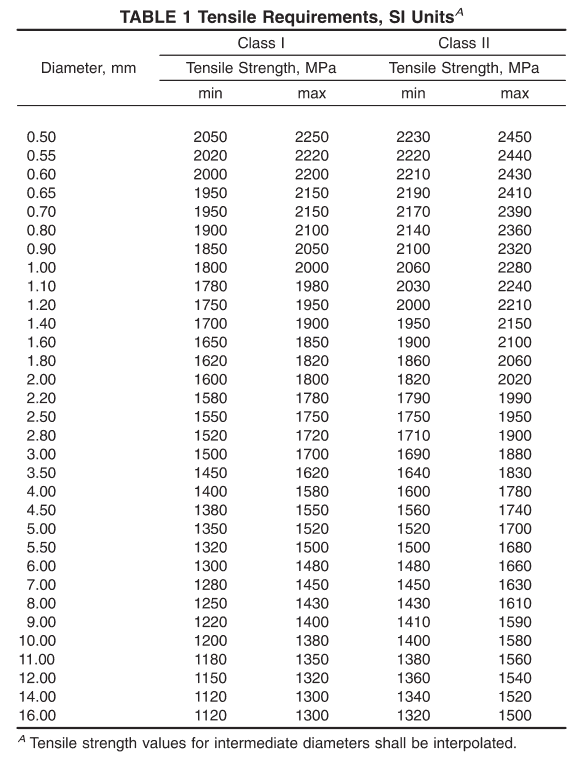
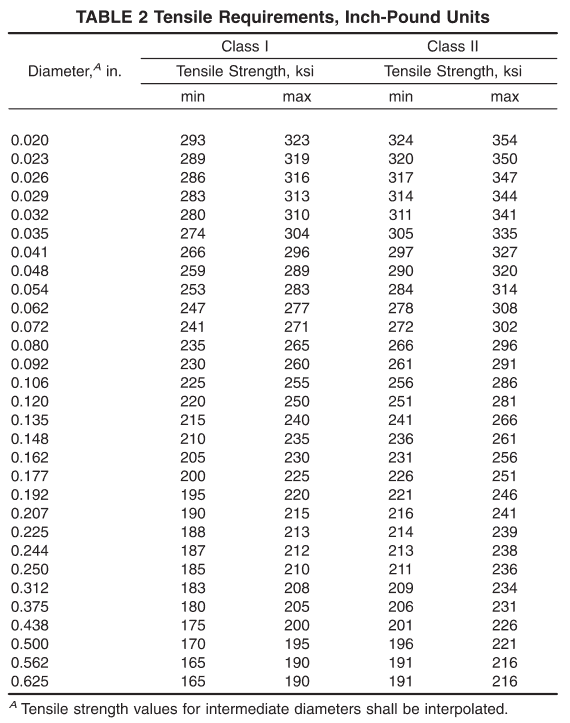
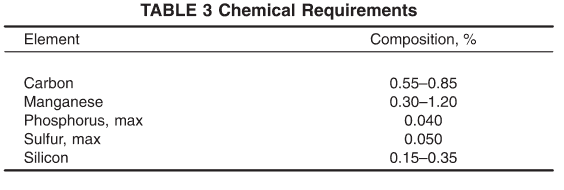
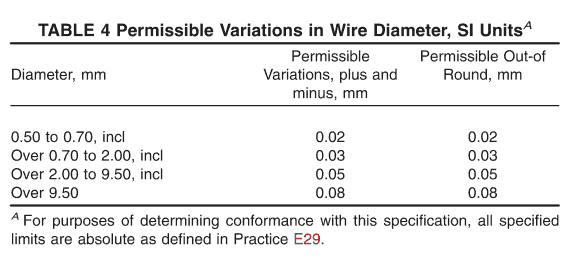
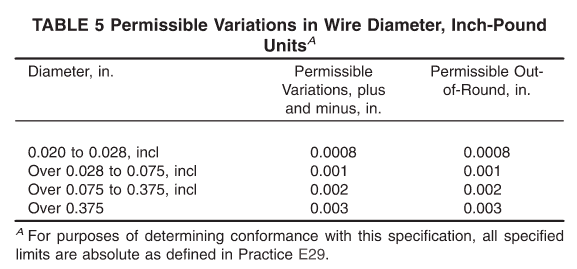
4.2 The purchaser shall have the option to specify additional requirements, including but not limited to:
4.2.1 Requirements for certifications, reporting of heat analysis or test reports (see Sections 15 and 7)
4.2.2 Special packing, marking, and loading requirements, and
4.2.3 Other special requirements, if any.
- General Requirements
5.1 Material furnished to this specification shall conform to the applicable requirements of Specification A510/A5 10M.
- Materials and Manufacture
6.1 The steel may be made by any commercially accepted steel- making process. The steel shall be fully killed.
6.2 The finished wire shall be free of detrimental pipe and undue segregation.
6.3 The wire shall be quenched and tempered to produce the desired mechanical properties.
- Chemical Composition
7.1 The steel shall conform to the requirements for chemical composition prescribed in Table 3.
7.2 Cast or Heat Analysis- -Each cast or heat of steel shall be analyzed by the manufacturer to determine the percentage of elements prescribed in Table 3. This analysis shall be made from a test specimen preferably taken during the pouring of the cast or heat. When requested, this shall be reported to the purchaser and shall conform to the requirements of Table 3.
7.3 Product Analysis- An analysis may be made by the purchaser from finished wire representing each cast or heat of steel. The chemical composition thus determined, as to elements required or restricted, shall conform to the product analysis requirements specified in Table 7 of Specification A510/A5 10M.
7.4 For referee purposes, Test Methods, Practices, and Terminology A751 shall be used.
- Mechanical Properties
8.1 Tension Test:
8.1.1 Requirements- -The material as represented by tension test specimens shall conform to the requirements prescribed in Table 1 or Table 2. Tensile strength of shaped wires shall conform to either table based on the conversion to equivalent round diameter.
8.1.2 Number of Tests- _One test specimen shall be taken for each ten coils or fraction thereof, in a lot. Each heat in a given lot shall be tested.
8.1.3 Location of Tests- -It shall be permissible to take test specimens from either end of the coil.
8.1.4 Test Method- The tension test shall be made in accordance with Test Methods and Definitions A370. For shaped wires, cross sectional area shall be calculated either by
using the procedure in Test Methods E8/E8M for uniform but nonsymmetrical cross-sections, or by measuring width and thickness and mutiplying by a shape factor.
8.1.4.1 Upon agreement between purchaser and supplier, the shape factor for the cross section design provided by the wire mill shall be permissible to be adopted for use. In other situations if the shape factor is not available from the wire mill, the shape factor shall be calculated by measuring the cross sectional area in accordance with Test Methods E8/E8M and dividing by the width and thickness.
8.2 Wrap Test:
8.2.1 Requirements- _Wire 4.00 mm [0.157 in.] and smaller in diameter shall wind on itself as an arbor without breakage. Larger diameter wire, up to and including 8.00 mm [0.315 in.] shall wind, without breakage, on a mandrel twice the wire diameter. Wrap test is not applicable to wires over 8.00 mm [0.315 in.] in diameter or to shaped wires.
8.2.2 Number of Tests- _One test specimen shall be taken for each ten coils, or fraction thereof, in a lot. Each cast or heat in a given lot shall be tested.
8.2.3 Location of Test- -It shall be permissible to take test specimens from either end of the coil.
8.2.4 Test Method- The wrap test shall be made in accordance with Test Methods and Definitions A370, Annex A4.
- Metallurgical Requirements
9.1 Surface Condition- The surface of the wire as-received shall be free of rust and excessive scale. No serious die marks, pits, scratches, or other surface imperfections detrimental to the end application shall be present. The level, depth, or severity beyond which these surface imperfections are unacceptable may be further defined and agreed upon by the producer and the purchaser.
9.1.1 Number of Tests- One test specimen shall be taken for each ten coils or fraction thereof, in a lot.
9.1.2 Location of Test- Representative test specimens shall be taken from either or both ends of the coil.
9.2 Decarburization, Seam Depth, and Microstructure — The maximum depth of decarburization (free ferrite plus partial decarburization) shall not exceed 2% of the equivalent round wire diameter or 0.15 mm [0.006 in.] whichever is less. The depth of complete decarburization (free ferrite) shall not exceed 0.75% of the wire diameter.
eams shall not exceed 3.5 % of theequivalent round wire diameter or 0.25 mm [0.010 in.], whichever is less. Except for surface locations affected by decarburization, the wire shall have a fine, homogeneous, tempered martensite microstructure.
9.2.1 Number of Tests- -Where required by the purchaser, one test specimen shall be taken for each ten coils, or fraction thereof, in a lot and each cast or heat in a given lot shall be tested.
9.2.2 Location of Test- Representative test specimens shall be taken from either or both ends of the coil.
9.2.3 Test Method- _Decarburization and seam depth shall be determined by chemical etching a suitably polished transverse section of wire, though seam depth may be determined without etching. The entire periphery to be examined should be in a single plane with no edge rounding.
9.2.4 Examination shall be performed at a magnification of no less than 100x for depth of free ferrite and maximum affected depth. Smaller wire sizes may require higher magnification. Measure the worst area present excluding decarburization associated with seams or other surface imperfections. Complete decarburization exists when only free ferrite is present. Partial decarburization exists when ferrite is found mixed with pearlite or tempered martensite. Structures of 100 % martensite shall be defined as not decarburized.
9.2.5 Examination shall be performed at a magnification of no less than 100x for depth of seams. Smaller wire sizes may require higher magnification. Measure the seam having greatest depth as measured perpendicular to the wire surface.
9.2.6 Examination shall be performed at a magnification of no less than 100x for microstructure. Either the same suitably polished and chemically etched transverse section used for assessment of decarburization and seam depth or another suitably polished transverse or longitudinal section may be used.
- Dimensions and Permissible Variations
10.1 The permissible variations in the diameter of the wire shall be as specified in Table 4 or Table 5. Any definition of shaped tolerances shall be agreed upon by the producer and the purchaser.
- Uniformity, Straightness, and Continuity
11.1 The wire shall be uniform in quality and temper and shall not be wavy or crooked.
11.2 Each coil shall be one continuous length of wire, properly coiled and firmly tied. Welds made prior to cold drawing are permitted.
- Retests
12.1 If any test specimen exhibits obvious defects or shows the presence of a weld, it may be discarded and another specimen substituted.
- Inspection
13.1 Unless otherwise specified in the contract or purchase order, the manufacturer is responsible for the performance of all inspection and test requirements specified in this specification,excluding testing for decarburization, seam depth, and microstructure. Except as otherwise specified in the contract or purchase order, the manufacturer may use his own or any other suitable facilities for the performance of the inspection and test requirements unless disapproved by the purchaser at the time the order is placed. The purchaser shall have the right to perform any of the inspections and tests set forth in this specification when such inspections and tests are deemed necessary to assure that the material conforms to prescribed requirements.
- Rejection and Rehearing
14.1 Unless otherwise specified, any rejection based on tests made in accordance with this specification shall be reported to the manufacturer as soon as possible so that an investigation may be initiated.
14.2 The material shall be adequately protected and correctly identified in order that the manufacturer may make a proper investigation.
- Certification
15.1 When specified in the purchase order or contract, a manufacturer ‘s or supplier’s certification shall be furnished to the purchaser that the material was manufactured, sampled, tested, and inspected in accordance with this specification, has been found to meet the requirements of this specification, and remains in conformance with this specification at time of shipment. When specified in the purchase order or contract, a report of the test results shall be furnished.
15.2 The certification shall include the specification number, year date of issue, and revision letter, if any.
- Packaging, Marking, and Loading for Shipment
16.1 The coil mass, dimensions, and the method of packaging shall be agreed upon between the manufacturer and purchaser.
16.2 A tag shall be securely attached to each coil of wire with identifying information as agreed upon by the purchaser and manufacturer.
16.3 Unless otherwise specified in the purchaser’s order, packaging, marking, and loading for shipments shall be in accordance with those procedures recommended by Practices A700.
17 Keywords
17.1 springs; tempered; wire
